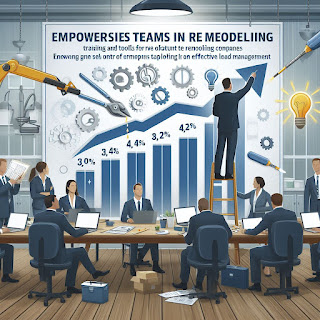A Remodel Cloud Blog
Last Updated: Jun 18, 2025 01:40:34
In the remodeling industry, professionalism isn't just about the quality of the build, it’s also reflected in your communication, contracts, and documentation. This Remodel Cloud Spotlight is on one of the most powerful (and often underutilized) features in our remodeling software: Custom Document & Contract Templates.
Why Templates Matter
Remodeling businesses juggle countless documents, emails, estimates, contracts, invoices, change orders, and specifications. Doing these manually or piecing them together from scattered files wastes time and increases the risk of mistakes.
That’s why Remodel Cloud built a flexible templating system designed specifically for remodelers and integrated with your Remodel Cloud Business System. It saves time, ensures consistency, and gives your brand a polished and professional edge.
What Can You Customize?
-
Contract AgreementsSet up legal language and scope-of-work details that automatically pull in client info, project dates, payment schedules, and more.
-
Change Order Agreements
Generate detailed change order forms that clients can review and approve digitally, complete with cost updates and revised timelines. -
Customer Specifications
Create templates that walk clients through finishes, selections, and install notes. No more confusion over which tile goes where. -
Invoices
Custom-branded invoices that reflect your terms, logo, payment methods, and line-item breakdowns for full transparency. -
Email Templates
Automate email follow-ups, appointment reminders, or proposal deliveries with clean, branded messaging, no copying and pasting required.
How It Works
Each template is powered by smart fields, dynamic placeholders that pull in real-time project data like customer names, addresses, job details, and pricing. You set the structure and style once, and the software handles the rest.
Want different templates for design-build, handyman, or kitchen remodels? You can create as many variations as your business needs.
The Big Impact
Custom templates don’t just streamline your admin work—they improve your client experience, reduce costly errors, and help close deals faster.
Whether you’re a one-person crew or a multi-crew operation, professional documentation is no longer optional—it’s your competitive edge.
Ready to Upgrade Your Docs?
If you’re still using Word docs and manual emails, it’s time to evolve. Our custom document and contract templates bring your entire process under one roof and make you look good while doing it.
Big news! Remodel Cloud just made your life easier, and your accountant’s life a whole lot happier. We’re thrilled to announce our sparkling new integration with QuickBooks Online.
Yes, you heard that right. It’s like Batman and Robin, peanut butter and jelly, or coffee and... more coffee.
Why Does This Mean For You?
Let’s be real. Running a remodeling business is like juggling power tools while riding a unicycle on a roof. You're managing jobs, teams, customers, timelines, and budgets. The last thing you need is to also wrestle with spreadsheets, invoices, and the occasional panic attack when tax season rolls around. By integrating QuickBooks with Remodel Cloud, we’re giving you superpowers you didn’t know you needed.
Say goodbye to duplicate data entry! With just a few clicks, your jobs, customers, invoices, and payments sync directly from Remodel Cloud to QuickBooks Online. It's like magic, except it’s real and doesn’t require a wand (or a wizard).
Simply log into Remodel Cloud using your QuickBooks Online login. That's it. You are now connected to QuickBooks Online and the QB Sync Action is available to use. We believe that Accounting packages should do the Accounting while Remodel Cloud will track Customers, Sales, and Jobs. If you can follow a recipe for microwave popcorn, you can do this.
Automation is the name of the game. Remodel Cloud pushes the customer and job details; QuickBooks takes it from there. That means fewer errors, faster billing, and more time to do literally anything else. Like actually enjoying your weekends.
Invoices are a two-way sync and can be entered into Remodel Cloud or QuickBooks. Remodel Cloud's synchronization engine will recognize new invoices and push either to Remodel Cloud or to QuickBooks. Payments always originate in Accounting and can be synchronized to Remodel Cloud.
Running your remodeling business should be exciting, not exhausting. With Remodel Cloud and QuickBooks Online working together, you get more time to focus on what you do best, like building beautiful things and keeping your customers happy.
So go ahead, ditch the spreadsheets, embrace the sync, and let Remodel Cloud + QuickBooks Online make your business (and your books) a whole lot smoother.
Your future self—and your accountant—will thank you.
Estimating costs accurately is essential in remodeling and construction projects. Whether you're a seasoned contractor or a DIY enthusiast, miscalculations can lead to budget overruns, delays, and dissatisfaction. To ensure your project stays on track financially, it's crucial to steer clear of common estimating mistakes. In this article, we'll highlight five of these mistakes and offer tips on how to avoid them.
Underestimating Materials Costs: One of the most prevalent errors in estimating is underestimating the cost of materials. This can occur due to various factors, such as failing to account for fluctuations in material prices, overlooking the need for specific materials, or relying on outdated pricing information. To avoid this mistake, research current material costs thoroughly, consider potential price changes, and always add a buffer to your estimates to account for unforeseen expenses.
Ignoring Hidden Expenses: Remodeling and construction projects often involve hidden expenses that are easy to overlook during the estimation process. These can include permit fees, subcontractor costs, equipment rentals, and disposal fees. Ignoring these expenses can significantly impact your budget and timeline. Make sure to conduct a comprehensive assessment of all potential costs associated with the project and factor them into your estimates from the outset.
Failing to Account for Labor Costs: Labor costs are another crucial aspect of estimating that is frequently underestimated. It's essential to accurately assess the amount of time and manpower required for each phase of the project and factor in the associated labor costs accordingly. Additionally, be sure to account for overtime, unexpected delays, and any specialized skills that may command higher wages. By properly accounting for labor costs, you can avoid budgetary surprises down the line.
Overlooking Scope Creep: Scope creep refers to the gradual expansion of a project's scope beyond its original boundaries. This often occurs due to client requests for additional features or changes to the initial plan. While accommodating client needs is important for customer satisfaction, failing to properly manage scope creep can wreak havoc on your budget and timeline. To avoid this mistake, establish clear project objectives and communicate them effectively with all stakeholders. Additionally, document any changes to the scope of work and adjust your estimates accordingly to reflect the added costs and time requirements.
Relying Too Heavily on Rules of Thumb: While rules of thumb can be useful for rough estimates, relying too heavily on them can lead to inaccuracies. Every project is unique, and factors such as location, project complexity, and materials used can significantly impact costs. Instead of relying solely on generic rules of thumb, take the time to thoroughly analyze each project's specific requirements and develop customized estimates based on accurate data and detailed calculations.
Accurate estimating is essential for the success of remodeling and construction projects. By avoiding common estimating mistakes such as underestimating materials costs, ignoring hidden expenses, failing to account for labor costs, overlooking scope creep, and relying too heavily on rules of thumb, you can ensure that your project stays on budget and on schedule. Remodel Cloud was constructed to help avoid the common pitfalls of estimating and ensure your business can communicate effectively with stakeholders, develop detailed estimates, and set your project up for success from the start.
In today's digital age, choosing the right software deployment model is crucial for businesses looking to streamline their operations, enhance productivity, and stay competitive. This decision is particularly significant when it comes to estimating software, as it directly impacts a company's ability to accurately forecast project costs, manage resources efficiently, and ultimately, deliver projects on time and within budget.
Two primary deployment models dominate the landscape: Software as a Service (SaaS) (i.e. Remodel Cloud) and On-Premise solutions. Each option offers distinct advantages and considerations, making the choice between them a critical decision for organizations of all sizes. Let's explore the key factors to consider when deciding between SaaS and On-Premise estimating software.
Understanding SaaS Estimating Software
SaaS estimating software, such as Remodel Cloud, are also known as cloud-based solutions, operates on a subscription model where users access the software via the internet. This model eliminates the need for companies to install and maintain software on their own servers, as all data and applications are hosted and managed by the software provider. Key characteristics of SaaS estimating software include:
Accessibility: SaaS solutions offer unparalleled accessibility, allowing users to access the software from anywhere with an internet connection. This accessibility is particularly advantageous for remote teams or organizations with multiple offices.
Scalability: SaaS solutions are highly scalable, enabling businesses to easily adjust their subscription plans to accommodate growth or fluctuations in demand. This scalability ensures that organizations can scale their estimating software in line with their evolving needs.
Automatic Updates: SaaS providers handle all software updates and maintenance tasks, ensuring that users always have access to the latest features and enhancements without the need for manual intervention.
Cost Structure: SaaS estimating software typically operates on a subscription-based pricing model, with fees typically charged on a monthly or annual basis. This predictable cost structure eliminates upfront capital expenditures and allows businesses to budget more effectively.
Exploring On-Premise Estimating Software
On-Premise estimating software, as the name suggests, is installed and run on servers located within the organization's premises. Unlike SaaS solutions, On-Premise software requires businesses to purchase and maintain their own hardware infrastructure, as well as handle software installation and updates internally. Key characteristics of On-Premise estimating software include:
Control: On-Premise solutions offer businesses greater control over their software environment, as all data and applications are hosted internally. This level of control can be appealing to organizations with strict data security or compliance requirements.
Customization: On-Premise software solutions often provide greater flexibility for customization and integration with existing systems, allowing businesses to tailor the software to their specific needs and workflows.
Data Security: For businesses handling sensitive or confidential data, On-Premise solutions may offer greater peace of mind, as they have direct control over data storage and security measures.
Upfront Costs: Unlike SaaS solutions, On-Premise software typically requires a significant upfront investment in hardware, software licenses, and implementation costs. Additionally, businesses are responsible for ongoing maintenance and support expenses.
Choosing the Right Deployment Model
When deciding between SaaS and On-Premise estimating software, businesses must carefully evaluate their specific requirements, preferences, and constraints. Consider the following factors:
Budget: Assess your budget constraints and determine whether a predictable subscription-based model (SaaS) or upfront capital expenditure (On-Premise) aligns better with your financial objectives.
Accessibility and Mobility: Consider the importance of remote access and mobility for your team. If remote work is prevalent or if you require access from multiple locations, a SaaS solution may be more suitable.
Scalability: Evaluate your organization's growth projections and determine whether scalability is a critical factor. SaaS solutions offer seamless scalability, whereas On-Premise solutions may require additional investments in hardware and infrastructure as your business expands.
Security and Compliance: Assess your data security requirements and regulatory compliance obligations. Determine whether the level of control offered by an On-Premise solution is necessary to meet your security and compliance needs.\
Customization and Integration: Consider the level of customization and integration capabilities required to align the estimating software with your existing workflows and systems.
Choosing between SaaS and On-Premise estimating software involves careful consideration of factors such as accessibility, scalability, control, security, and cost. By evaluating your organization's specific needs and priorities, you can make an informed decision that aligns with your business objectives and sets you up for success in project estimation and management. Whether you opt for the flexibility of SaaS or the control of On-Premise, investing in the right estimating software deployment model can empower your team to deliver projects more efficiently and effectively.
The Remodel Cloud team is first and foremost skilled technology consultant and would very much like to show and demonstrate the advantages of our SaaS solution. Contact Remodel Cloud to learn more about both SaaS and on-premise solutions.
Remodel Cloud believes the success of sales teams hinges on their ability to effectively manage leads. Empowering sales teams with the right training and tools is crucial for driving growth and staying ahead of the competition. In this blog post, we'll explore the strategies and tools that remodeling companies can employ to empower their sales teams for efficient lead management.
Understanding the Sales Process:
Before diving into lead management strategies, it's essential for sales teams to have a solid understanding of the remodeling sales process. This includes everything from lead generation to closing the deal. By comprehensively understanding each stage, sales professionals can better tailor their approach to meet the needs of potential clients.
Product Knowledge Training:
A knowledgeable sales team is a confident sales team. Providing in-depth training on your company's remodeling services, products, and solutions equips sales professionals to address customer inquiries with authority. Whether it's understanding the intricacies of different materials or the latest trends in home design, product knowledge training is essential for building trust with potential clients.
Sales Techniques and Skills Training:
In addition to product knowledge, sales teams need to master essential sales techniques and skills. This includes active listening, objection handling, relationship building, and effective communication. Role-playing exercises and ongoing training sessions can help sharpen these skills and keep sales teams at the top of their game.
Lead Management Training:
Effective lead management is the cornerstone of successful sales operations. Sales teams should be trained on lead qualification criteria, lead nurturing strategies, follow-up protocols, and time management techniques. By implementing standardized processes, sales professionals can efficiently move leads through the sales pipeline while providing a personalized experience for each client.
CRM Tools:
Investing in a robust Customer Relationship Management (CRM) system is essential for streamlining lead management processes. CRM tools allow sales teams to track leads, manage customer interactions, schedule follow-ups, and analyze sales data. With features like lead scoring and automated workflows, CRM tools empower sales professionals to prioritize their efforts and focus on high-potential leads.
Proposal and Quoting Tools:
Creating professional-looking proposals and quotes is a time-consuming task for sales professionals. Utilizing specialized software can streamline this process, allowing sales teams to generate accurate proposals quickly. Look for tools that offer customization options, integration with CRM systems, and analytics capabilities to track proposal success rates.
Continuous Learning and Development:
Sales techniques and market trends evolve rapidly, making continuous learning essential for sales teams. Encourage ongoing education through industry conferences, webinars, and internal training sessions. By staying ahead of the curve, sales professionals can adapt their strategies to meet changing customer needs and market dynamics.
Feedback Mechanisms:
Lastly, establish feedback mechanisms to gather insights from sales teams regarding the effectiveness of training programs and the usability of sales tools. Soliciting feedback allows companies to identify areas for improvement and make data-driven decisions to optimize their sales enablement efforts.
Remodel Cloud and our partners believe that empowering sales teams with comprehensive training and cutting-edge tools is paramount for effective lead management in remodeling companies. By investing in the development of sales professionals and providing them with the resources they need to succeed, companies can drive growth, build lasting customer relationships, and stay ahead in a competitive market.
"If you don't know your costs, you are going out of business.... you just don't know it yet!" - Business Mentor 1999
Accurate job costs are the result of an up to date cost book and a comprehensive estimating process. Construction and Remodeling Estimating Software system help you manage cost books and automate the estimating process. Software tools like Remodel Cloud will bake the profit margin into the estimate while giving the user the ability to control margins for specific jobs across labor, material , and other job costs.
Markup and margin represent different aspects of a business's financial performance. Here's a brief explanation of each:
Markup:
- Definition: Markup is the percentage difference between the cost of goods or services and their selling price. It is essentially the profit percentage added to the cost to determine the selling price.
- Formula: Markup Percentage = ((Selling Price - Cost Price) / Cost Price) * 100
- Example: If a product costs $50 to produce, and it is sold for $75, the markup percentage would be ((75 - 50) / 50) * 100 = 50%.
Margin:
- Definition: Margin, on the other hand, is the percentage difference between the selling price and the profit. It represents the portion of the selling price that is profit.
- Formula: Profit Margin Percentage = ((Selling Price - Cost Price) / Selling Price) * 100
- Example: Using the same example, if a product is sold for $75 and it cost $50 to produce, the profit margin would be ((75 - 50) / 75) * 100 = 33.33%.
In summary, markup is calculated based on the cost of goods, while margin is calculated based on the selling price. Both metrics are important for businesses to understand their pricing strategies and profitability.
manage your financial needs ensuring your jobs are profitable and notifying you when your profit is in jeopardy. Learn more by contacting Remodel Cloud for demo to see exactly how Remodel Cloud's Margin and Project Management help ensure you are profitable.
Let's start with sales. There are no construction or remodeling projects without sales. Sales teams contribute directly to the financial success and growth of the business by actively pursuing and closing deals. Construction management software systems should include all the tools you need for customer acquisition and relationship building. This includes tools to help track and manage the process of lead generation, lead qualification, prospect nurturing, and finally conversion to customers.













